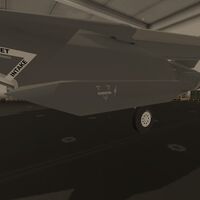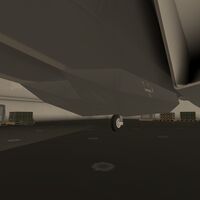AN/ALQ-245
- "An advanced multi-band radar jammer with multiple electronic attack/defense modes. It is powered by a built-in ram air turbine which deploys a variable intake scoop to power it as necessary."
- ― Equipment Description
The AN/ALQ-245 is an advanced electronic warfare pod exclusive to the EF-24G. Available on 2 sets of pylons, two wing-mounted and two undercarriage-mounted, these pods allow access to the electronic warfare suite for both offensive and defensive jamming.
Usage
The status of each pod can be managed through the XMIT page. Each pod contains a pair of transmitters, and can split power between the two. Transmitters can be set to three modes: NOISE, DRFM, and SAS. Once a target has been selected via the Tactical Situation Display, Targeting Pod, GPS, or the FRAZ page, it will transmit in the target's direction with its selected jamming mode.
Jamming Modes
Noise
The NOISE mode is the simplest form of jamming that works by overwhelming the target radar with a large amount of noise, making it very difficult to find any actual radar returns within the cone of effect.
Enemy aircraft will see this effect as green squares on their radar display. While receiving noise jamming, real radar returns will be obscured within the noise until the target is inside the "burn-through" range. Increasing power creates more noise and lowers the radar's effective burn-through range.
Noise jamming can be done on the LOW, MID, and HI bands. Note that the aircraft's own Fire Control Radar cannot be used while any jammer is transmitting noise.
| NOISE Band | Effective against... |
|---|---|
| LOW |
|
| MID |
|
| HI |
|
| Noise jamming is not effective against internal missile radars and Single Target Track locks. DRFM is better suited to these threats. | |
DRFM
The DRFM mode works by receiving incoming radar pulses, modifying them, and retransmitting radar returns back to the enemy. By default, DRFM will automatically select the correct band to transmit on according to your target.
To radars in search mode, this effect will appear as a cluster of false radar contacts around your aircraft. Increasing transmission power or painting a target with multiple DRFM jammers creates more false radar contacts. Be aware that your own aircraft's true radar returns are included among them.
To radars in Single Target Track mode, the DRFM transmitter will attempt to break the lock using RGPO. By exploiting where the enemy radar expects your aircraft to be (the range gate), DRFM will transmit a stronger false return within the bounds of the enemy's radar lock and direct it away from you, eventually breaking the STT lock. Increasing transmitter power on a target with an STT lock will increase effectiveness of the RGPO.
DRFM jamming does not prevent use of the Fire Control Radar.
SAS
The SAS mode works similarly to DRFM; the SAS jammer will receive incoming radar pulses and send them back as incorrect aircraft returns. The end result is that an aircraft can disguise itself as a different vehicle. It is possible for the EF-24G to disguise it as any other allied aircraft, such as an F/A-26B or a B-11.
SAS spoofing will increase detection range according to the power allocated to the transmitter. Consider lowering power to SAS jammers to appear on radar at a more reasonable range.
SAS jamming also does not prevent usage of the Fire Control Radar.


